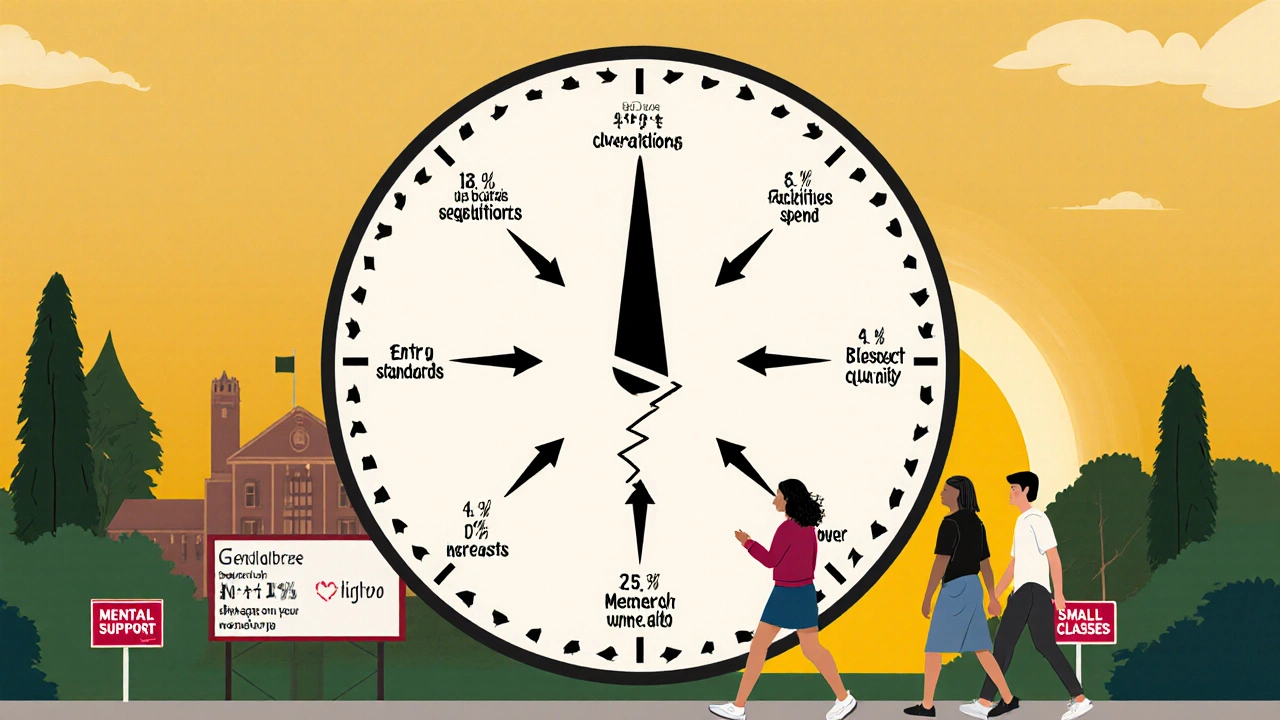
Every year, millions of students and parents stare at university rankings like they’re a map to the future. But what do these numbers actually mean? And why does a school jump from 15th to 8th overnight? The Complete University Guide rankings aren’t magic. They’re built from real data-some of it surprising, some of it misleading. If you’re trying to pick a university, you need to know what’s behind the numbers, not just the list.
What the Complete University Guide Actually Tracks
The Complete University Guide doesn’t guess. It doesn’t rely on reputation surveys alone. It uses nine specific metrics, all pulled from official UK government data and student feedback. Each one is weighted differently, and together they paint a picture of what it’s really like to study at a university.
Here’s what they measure:
- Student Satisfaction - From the National Student Survey (NSS). How happy are students with teaching, feedback, and course quality?
- Entry Standards - Average UCAS points of incoming students. This shows how selective a course is.
- Student-Staff Ratio - How many students are assigned to each academic staff member. Lower numbers usually mean more personal attention.
- Academic Services Spend - Money spent per student on libraries, IT, and learning resources.
- Facilities Spend - Investment in labs, studios, sports centers, and other physical resources.
- Graduate Prospects - What percentage of graduates are in work or further study 15 months after finishing.
- Research Quality - Based on the Research Excellence Framework (REF). How much high-impact research does the department produce?
- Research Volume - How much research is being done, not just how good it is. Measured by staff numbers and output.
- Degree Completion - The percentage of students who finish their degree. High dropout rates drag a university down.
Each metric gets a score from 0 to 100. Then they’re combined into one overall score. The university with the highest total ranks first. Simple? Not quite.
Why Rankings Can Mislead You
Let’s say University A ranks higher than University B. Does that mean it’s better for you? Not necessarily.
Take entry standards. A school with high entry scores might be harder to get into, but that doesn’t mean it teaches better. It just means it attracts students who already scored well in their A-levels. If you’re a student who learns differently or needs more support, a lower-ranked school might give you better outcomes.
Another trap: research quality. A university might rank high because its professors publish groundbreaking papers. But if you’re an undergrad, you’ll rarely interact with those researchers. Your experience depends on teaching staff-who might be overworked or underpaid.
And then there’s facilities spend. A shiny new sports center or renovated library sounds great. But if that money comes at the cost of fewer tutors or outdated course materials, it’s not helping your grades.
Rankings are averages. They don’t show what happens to you. A school might have a 95% degree completion rate overall-but if you’re in a niche subject with only 20 students, the support you get could be completely different from the average.
How Rankings Are Used-and Abused
Universities treat rankings like a scoreboard. When they move up, they send press releases. When they drop, they launch “improvement plans.” Some even change how they report data to look better.
One university in 2023 quietly shifted its “graduate prospects” calculation to include part-time work in retail as “employment.” It boosted their score by 7 points overnight. No one noticed until a student blog dug into the raw data.
Meanwhile, students use rankings to decide where to apply. But the top 10 schools get 60% of all applications-even though they only educate 20% of undergraduates. That creates a vicious cycle: the most popular schools get more funding, more applicants, and higher rankings, while other schools struggle to be seen.
There’s also a geographic bias. London and southern universities often rank higher because they have more funding, more research grants, and higher living costs-which inflate spending metrics. A university in the North West might offer the same degree, better student support, and lower tuition, but rank lower simply because it spends less per student.

What the Rankings Don’t Tell You
Here’s what you won’t find in the Complete University Guide:
- How supportive the mental health services are
- Whether international students feel welcome
- If the course changes every year
- How easy it is to switch majors
- Whether internships are built into the curriculum
- How many students get real industry experience
- What the campus culture is like after 5 p.m.
These things matter. A lot. A student who feels isolated, overwhelmed, or unsupported won’t care how high the ranking is. They’ll care about the person who answered their email at 11 p.m. before their deadline. The professor who stayed late to explain a concept. The career advisor who helped them land an internship.
Some universities don’t even track this data. Others do-but they don’t report it to the Complete University Guide. So if you’re looking for a school that helps you grow beyond grades, you need to dig deeper.
How to Use Rankings Wisely
Rankings aren’t useless. They’re a starting point. Here’s how to use them without being fooled:
- Look at the individual metrics-not just the overall rank. If you care about teaching quality, focus on student satisfaction and student-staff ratio. Ignore research volume if you’re not planning to do a PhD.
- Compare schools in your subject. A university might rank 40th overall but be top 5 for psychology. That’s the one you want.
- Check the year. Rankings change. A school that was #3 in 2022 might be #18 in 2025. Don’t rely on old lists.
- Read student reviews. Look for patterns. Are people complaining about the same thing? Lack of feedback? Poor library hours? That’s real.
- Visit if you can. Walk around campus. Talk to current students. Ask: “What’s one thing you wish you’d known before starting?”
Don’t pick a school because it’s ranked high. Pick it because it fits your goals, your learning style, and your life.

What Happens When You Ignore the Rankings
There’s a growing group of students who do exactly that. They choose universities based on cost, location, course structure, and student support-not prestige.
One student in Manchester picked a university ranked 62nd for computer science. Why? Because it offered paid internships every year, had a 90% graduate employment rate, and let students switch to data science after Year 1. The top-ranked school didn’t offer any of that.
Another chose a university in Wales because it had smaller class sizes, free tutoring, and a 97% degree completion rate. The rankings didn’t reflect that. But the student’s transcript did.
These students aren’t settling. They’re choosing wisely. And they’re often the ones who end up with better jobs, less debt, and fewer regrets.
Final Thought: Rankings Are a Mirror, Not a Compass
The Complete University Guide rankings reflect what universities report, not what students experience. They’re useful for spotting trends, comparing spending, or seeing which schools are improving. But they can’t tell you if you’ll feel at home there. They can’t measure resilience, curiosity, or the quiet moments that make college meaningful.
Use them. But don’t let them decide for you.
Are university rankings reliable for choosing where to study?
They’re reliable as a starting point, but not as a final decision. Rankings measure what universities report, not what students actually experience. A high rank doesn’t guarantee good teaching, support, or happiness. Always check individual metrics and talk to current students.
Why do some universities rank higher even if they’re more expensive?
Higher spending on facilities and academic services boosts rankings. But that doesn’t mean better teaching. Some universities spend more on luxury buildings than on tutors. Always compare student satisfaction and graduate outcomes-not just total spend.
Do rankings affect job prospects after graduation?
For most jobs, no. Employers care more about your skills, internships, projects, and references than which university you attended. Only in highly competitive fields like law or finance do rankings matter significantly. Even then, your experience matters more.
Can a university manipulate its ranking?
Yes. Some universities adjust how they report data-like including part-time retail jobs in graduate employment stats, or shifting staff to boost student-staff ratios. Independent investigations have found these practices. Always cross-check rankings with student reviews and official government data.
What should I look for instead of rankings?
Look at course structure, internship opportunities, class sizes, student support services, and graduate employment rates in your specific field. Talk to current students. Visit the campus. Ask: “What’s one thing you wish you’d known before starting?” That’s more valuable than any number.